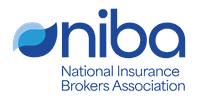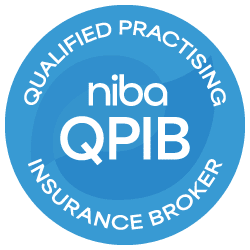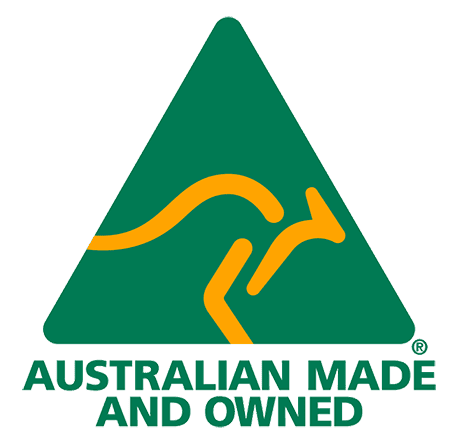Aviation Insurance Darwin & Northern Territory
Tailored Aviation Insurance for Darwin Pilots, Operators & Businesses
Aviation in the Top End poses unique challenges, so the cover you need must consider all factors affecting aerial activities in this part of Australia.
Whether you’re operating a commercial fleet out of Darwin International Airport or flying bush routes to Arnhem Land, AGL Aviation Insurance Brokers delivers protection that fits your aircraft, your operations, and special conditions in your area of coverage.
With decades of experience in the Australian aviation sector and strong relationships with leading underwriters, we help aircraft owners, instructors, and operators in Darwin and the Northern Territory get aviation insurance that actually makes sense for what they do.
Entrust your aircraft and your business to a broker that knows the Northern skies.
Get Your Free Aviation Insurance Quote Today!
Aviation in Darwin—Challenging and Diverse
Flying in Darwin and the Northern Territory can pose challenges in terms of distance, remote access, and weather extremes. Aviation in Darwin and its neighbouring areas is not merely about flying, as it includes essential activities like delivering health services to isolated communities, getting freight into the Outback, and making regional travel possible in places where road access isn’t always an option.
Aviation across Darwin and the broader Northern Territory depends on a network of public and private airfields, with each playing a critical role in connecting communities, supporting tourism, and enabling essential services.
- Darwin International Airport: The Territory’s primary aviation gateway, handling commercial airlines, general aviation, Royal Australian Air Force operations, and fly-in fly-out (FIFO) services to mining and remote sites.
- Tindal Airport (Katherine): A dual-use military and civilian airfield south of Darwin that supports charter flights, cargo runs, and emergency services to inland communities.
- Gove Airport (Nhulunbuy): Serves East Arnhem Land, acting as a vital link for passenger transport, freight delivery, and medevac services across the Gulf region.
- Alice Springs Airport: While located further south, it plays a strategic role in aviation across central Australia, offering general aviation, tourism, and maintenance services.
- Remote Airstrips: Bush strips and regional landing grounds from Wadeye and Borroloola to Elcho Island are essential for connecting Indigenous communities, cattle stations, and health outposts across the Top End.
The Territory’s reliance on aviation for essential services, tourism, agriculture, and logistics has created a high level of activity and risk diversity. Pilots here deal with everything from heavy monsoonal weather to cross-country fuel logistics.
AGL Aviation Insurance Brokers supports the Darwin aviation community by offering policies built around these real-world conditions, not just standard templates.
Our knowledge of remote flying, short gravel strips, and diverse aircraft use means we can provide reliable guidance and custom coverage for aircraft owners, operators, and businesses.
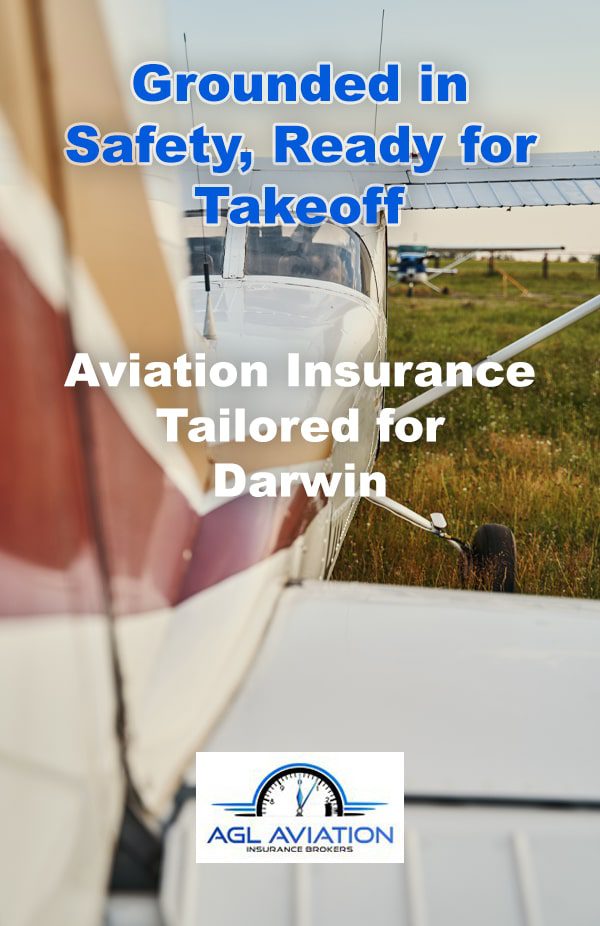
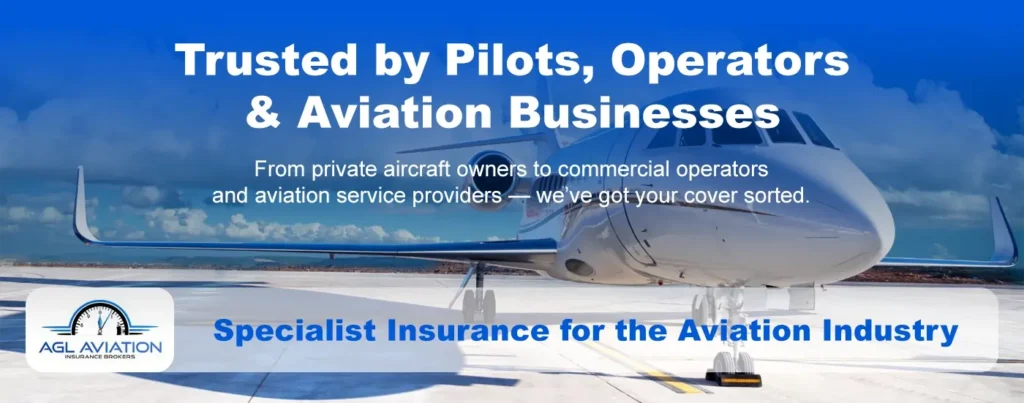
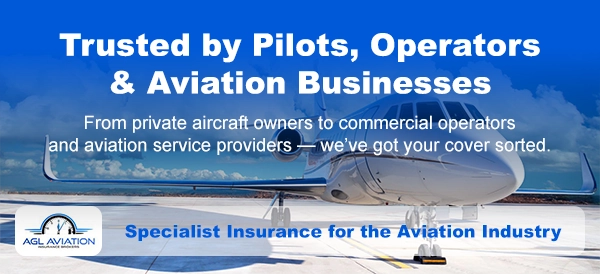
Who We Help
AGL Aviation Insurance Brokers deals with a wide range of clients across the Northern Territory and the rest of Australia, including Melbourne and Adelaide.
From remote charter pilots to training organisations at Darwin Airport, our clients rely on us for aviation insurance that reflects actual operating conditions, not guesswork.
We provide assistance to:
▶ Private Aircraft Owners
Whether you store your aircraft at Darwin International, use it for station runs, or base it at a remote airfield in the Barkly, we provide cover that considers heat, hangar access, security, and airfield surface types. We offer insurance for fixed-wing aircraft, gyrocopters, helicopters, and light sport aircraft, with specific provisions for single users and group ownership.
▶ Commercial Operators
Charter providers across Darwin and Northern Australia often operate under tight schedules and deal with unpredictable conditions most of the time. Whether you’re flying personnel to mining sites or supporting fly-in fly-out contracts, our cover addresses multiple aircraft, remote operations, variable loads, and route risk.
▶ Flight Schools & Instructors
The Darwin flight training sector continues to flourish, with schools operating from locations like Darwin International and Batchelor Airport. We assist instructors and training providers with insurance tailored for high turnover, student variance, and fleet rotation. Coverage extends to training aircraft, simulators, and instructors’ legal liability.
▶ Aerial Survey & Photography
Flying across remote zones like the Tanami or along the NT coastline requires permits, technical equipment, and mission-specific planning. Our insurance supports operators that conduct survey and photography missions, and engage in activities like protecting airframes and payloads. We offer third- party liability across single missions or ongoing contracts.
▶ Agricultural Aviation Operators
NT ag pilots regularly operate over difficult terrain, with varying characteristics like low-level flight paths and chemical application risks. From spraying in the Daly River region to crop dusting on cattle stations, our policies reflect the risks that come with hot climates, rugged terrain, and varied cargo.
▶ Rotary Wing Operators
Helicopters play a central role in the NT for medevac, sling work, inspections, and transport. We provide policies that take rotorcraft conditions seriously, such as engine stress from heat, limited landing options, and mission-critical operations.
Aviation Activities We Cover Across Darwin
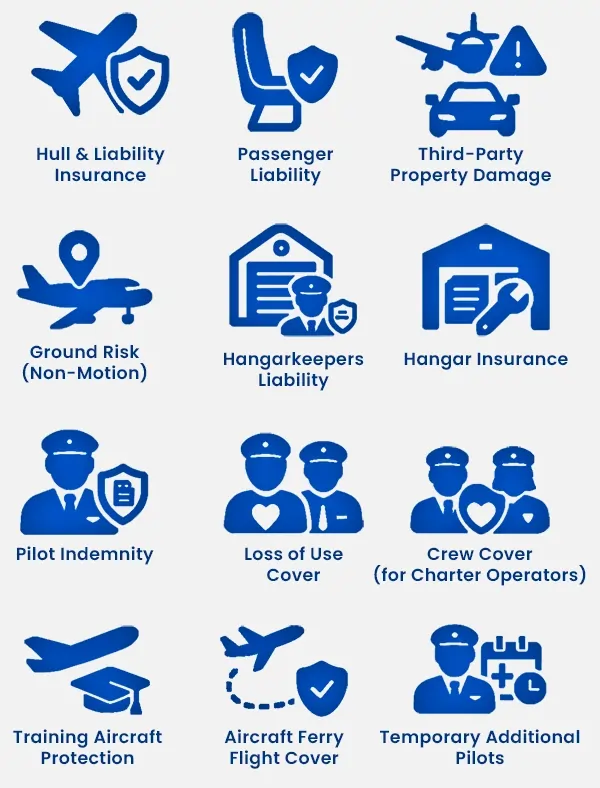
Aviation in the Northern Territory spans a wide range of sectors, each with its own requirements and demands. AGL Aviation Insurance Brokers delivers cover shaped by the specific type of operation and aircraft usage. If your business flies across the Top End, we’ll help you stay protected.
We insure:
- Private Flying: Pilots who use their aircraft for personal travel, cross-country trips, and property access throughout the NT need flexible cover. We account for shared ownership, remote landings, and storage in non-standard hangars.
- Charter Flights & Tourism: Scenic flights over Kakadu, transfers to fishing lodges, or air safaris to Arnhem Land all come with unique operational risks. We build charter insurance that considers variable routes, remote strips, and changing weather patterns.
- Cargo & Freight: NT freight operators deal with rough airstrips, remote fuel access, and temperature-sensitive payloads. Our cargo insurance supports bush routes and considers the insurance implications of time-sensitive deliveries.
- Pilot Training & Schools: High aircraft usage, student risk, and instructor coverage are key in the NT. We work with Darwin-based training schools and individual instructors to provide reliable protection for training fleets and liability under NT-specific conditions.
- Aerial Agriculture: Dust, heat, and tricky terrain are standard for ag pilots in the Top End. Our agricultural cover accounts for spraying operations, equipment value, payload contents, and chemical spill liability.
- Survey & Inspection: Survey operators involved in mapping, corridor inspection, or mining-related photography can expect customised coverage that calculates for expensive onboard tech and multiple missions.
- Emergency Medical Flights: Aeromedical flights in the NT often cover vast distances, sometimes combined with tricky weather conditions and terrain. Whether you’re based in Darwin or servicing Tennant Creek or Nhulunbuy, our cover factors in patient care equipment, pilot fatigue, and emergency landings.
- Specialist Aviation Work: Specialised flying includes aerial crane, law enforcement air support, firefighting reconnaissance, and wildlife tracking. Each operation comes with its unique risk environment or setting, so we tailor coverage accordingly.
Darwin Aviation Insurance Costs – What You Can Expect
Insurance costs for aviation aircraft in Darwin depend heavily on how, where, and how often your aircraft is used. Regional risk, aircraft value, and pilot experience are all key factors.
Here’s a rough pricing guide for aircraft in the Northern Territory:
- Light piston aircraft like a Cessna 172 or Piper Archer are generally insured for between AUD 2,500 to 7,000 per year, depending on use, hangaring, and pilot hours.
- Twin-engine aircraft such as a Baron or Seneca start around AUD 5,000, with premiums rising based on complexity and operational footprint.
- Turboprops like a King Air—common in charter or medevac work—may see annual premiums from AUD 10,000 up to 25,000+, depending on mission type and pilot qualifications.
- Helicopters used for commercial or government work may attract premiums from AUD 7,000 and up. Insurance for rotary-wing aircraft depends heavily on operating conditions, the number of landings per day, and mission type.
| Aircraft Type | Example Model | Estimated Premium Range Per Annum (AUD) | Remarks |
|---|---|---|---|
| Light piston aircraft | Cessna 172 | 2,500 – 7,000 | Basic hull and liability cover; depends on usage |
| Twin piston aircraft | Piper Seneca | 5,000 – 10,000 | Higher value, more complex; pilot experience matters |
| Turboprop | King Air 200 | 10,000 – 25,000+ | More expensive due to higher value and complexity |
| Helicopter | Bell 206 | 7,000+ | Risk profile and operational use impact helicopter insurance premium |
*NOTE: Pilot experience is a significant factor in the above costs.
To reduce costs, you should consider:
- Basing your aircraft in secure hangars whenever possible
- Completing advanced flight training
- Maintaining a low incident rate
AGL Aviation Insurance Brokers can assist you in calculating your premium.
We will review your usage pattern and help you get cost-effective coverage that doesn’t compromise on the protection you need.
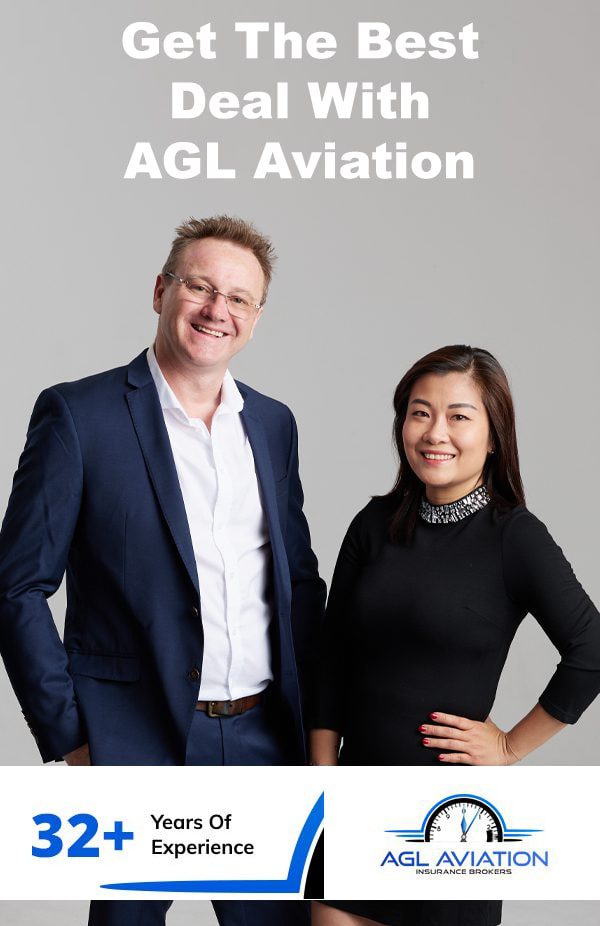
Why Darwin Aviators Trust AGL Aviation
We understand aviation in the Northern Territory because we’ve worked with the people who keep it running. From solo pilots to regional aviation businesses, our clients know they’re working with brokers
who’ve spent time around aircraft, not just policy paperwork.
Here’s why our Darwin-based clients prefer to work with us:
- Industry-Specific Knowledge: We know the difference between flying IFR over cities and running a piston twin from a dirt strip. From maintenance liability to freight risks, our advice is informed not only by data but, more importantly, by field experience.
- Local Airfield Familiarity: Our knowledge of local aviation hubs and operations includes Darwin International, Batchelor Airport, and other NT strips. We understand the practicalities of accessing hangar space, maintenance, and fuel in remote zones.
- Solid Underwriter Network: We work with top Australian aviation underwriters and reinsurers, so we can find the most practical options, even for unusual or high-risk aviation activities.
- Responsive, Clear Support: Quote turnaround is typically one to two business days. For renewals, changes, or urgent needs, our team responds promptly with full context on your policy.
- Straightforward Conversations: When you speak to us, you get aviation professionals, not general insurance call centres. We speak aviation, so we understand pilot qualifications, flight hour logs, and maintenance records.
- NT-Wide Capability: From aircraft based in Katherine to remote strips in East Arnhem, we’re set up to provide aviation insurance advice and service across all parts of the Territory.
How to Get Started
Get a Quote From AGL
Getting aviation insurance in Darwin shouldn’t be complicated. Our team makes it easy to get started so you can get tailored cover.
Step 1: Contact us via phone, online form, or email
Step 2: Provide basic details about your aircraft and how it’s used.
Step 3: Get a tailored quote quickly.
Reach out to AGL Aviation Insurance Brokers today to discuss your aircraft and operational profile. We’ll provide a quick turnaround on quotes and guide you through the next steps.
We not only provide policies but also ensure you understand what they do, what they don’t do, and how they fit your aircraft’s life cycle.
Fill Out Our Form for Your Custom Aviation Insurance Quote Today
Frequently asked questions
Aircraft Insurance Questions
Navigating aircraft insurance can raise a few questions — especially here in Darwin, where needs can vary widely. Our FAQ section is designed to clear up the confusion, answer your most common queries, and guide you confidently through the details. Dive in and get the clarity you need.
In general, quotes are returned within 1–2 business days. More complex risks may take slightly longer, especially if they involve multiple aircraft or specialist operations.
Yes, we provide hangar and ground risk cover for aircraft based at major and regional NT airports. We tailor policies to suit your hangar setup, security, and exposure.
Absolutely. We frequently work with clients based at remote airstrips and cattle station landing areas. Location does not affect our service.
Yes. For cross-border operations in Southeast Asia, we can advise on the exclusions and arrange international coverage that meets your operational scope.
We do offer insurance to students and low-hour pilots. We’ll match your situation with policies that reflect your stage of training, type of aircraft, and intended use.
Yes, provided the underwriter approves the pilot’s qualifications and experience. We’ll help manage that process for temporary co-pilots, instructors, or test pilots.
We can. If you’re conducting government-contracted air work, such as fire patrols, crocodile surveys, or border surveillance, let us know. We’ll create a policy that reflects those missions.
We insure commercial drone operators working under CASA rules. For example, if you’re filming construction sites or conducting environmental monitoring, we offer drone-specific cover.
Yes, provided the aircraft is rated and maintained appropriately. We’ll ensure your policy factors in wear and stress associated with Northern Territory conditions.
We may consider lowering your premium depending on certain conditions. Improving hangar security, upgrading pilot credentials, or demonstrating strong maintenance records can help. We’ll review your setup and offer suggestions.
Didn’t find the answers to your questions? Don’t hesitate to contact us.







